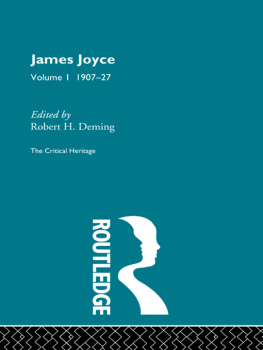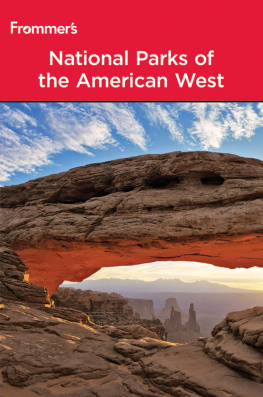JOURNEYS THROUGH AMERICAN HISTORY
Volume I: Native Americans and Revolutionary Times
By James T. Parks
We all owe a debt of gratitude to those intrepid souls who came before us; they forged the remarkable history of what became, and is, the United States of Americathank you! As we travel through Americas past and present, let us continue learning from and preserving the richness of our countrys incomparable parklands, iconic landscapes, historic places, diverse human cultures, and sacred sites. Of course, I would also like to thank my wife, Karen, for putting up with my many long hours spent on this project.
Journeys Through American History
This book is the first volume of a collection of RoadRUNNER travelogues written by James T. Parks, which focus on locations and routes steeped in American history. Jims original articles are scattered piecemeal throughout various RoadRUNNER bimonthly issues, spanning more than a decade of time. With that in mind, we have updated information, where feasible, that appeared in the original articles. Readers, who are interested in how America came to be what it is today, will find this integrated collection of historically themed adventures of particular interest, regardless of your mode of transportation.
Volume I focuses on Native American history and several revolutionary events that helped win our independence and build Americas industrial might. Come along with us and enjoy these journeys through American history.
Christa Neuhauser
Publisher & Editor-in-Chief
RoadRUNNER Motorcycle Touring & Travel magazine
2020 by RoadRUNNER Publishing division of European Creative Communication Inc.
ISBN: 978-1513660165 (paperback)
ISBN: 978-1513660172 (e-book)
Library in Congress Cataloging-in-Publication Data
Journeys Through American History, Vol. 1, James T. Parks
Printed in USA
Photography: James T. Parks, RoadRUNNER Publishing
First printing: March 2020
A COLORADO PLATEAU ODYSSEY IN AMERICAS FOUR CORNERS REGION
Its early September and the summer tourists have abandoned the 130,000-square-mile red rock landscape known by geologists as the Colorado Plateau. It contains the largest concentration of scenic wonders in America. Roughly centered where the states of New Mexico, Colorado, Utah and Arizona meet, the plateau was once home to the Anasazi, a largely vanished Native American culture that began living in this arid environment as early as 1200 B.C. The prospect of seeing archeological remnants of these ancient Puebloan people promises to make this trip an unforgettable adventure.
THE COLORADO PLATEAU
Hundreds of millions of years ago, shallow seas deposited layers of sediment several miles thick. Over the eons the seas receded and those sedimentary layers were forced deep into the earth where intense heat and pressure fused them into rock. Later, tectonic plate movement caused the entire western US to begin rising some 5-to-10 million years ago, forming the Rocky and Sierra Nevada mountain ranges. But the thick rocky crust of the Colorado Plateau didnt bend and fold from those forces. Instead, it was uplifted largely intact and then eroded into the dramatic red rock landscape we see today.
From Cuba, NM, my nephew Steve Brown and I travel northwest into an enormous landscape thats largely devoid of modern civilization. A thin ribbon of two-lane asphalt snaking its way across the plateau seems a tenuous human lifeline in this world of stone. Although the temperature is in the 80s, the combination of very low humidity and an altitude ranging from 6,000-to-7,000 feet makes travel and on-foot discovery quite comfortable. The feeling is both exhilarating and humbling, out here where the colossal forces of nature rule over mankind.
INTO CHACO CANYON
At the turn-off from US 550 to Chaco Culture National Historical Park, a sign indicates that theres no food, gas, or hotels from here on. All but 8 miles of this 21-mile road are dirt and gravel. We fly over the rutted-out, washboard roadway, and splash through a shallow water crossing, sending spray onto the dry desert surface. Then, the road subtly winds its way onto a dry wash canyon floor and were soon surrounded by Chaco Canyon.
Chaco Culture National Historical Park has one of the most extraordinary collections of ancient ruins north of Mexico. The parks mission is to carefully manage the exploration and preservation of these ancient dwellings.
At the Visitors Center we learn that Chaco Canyon was the cultural center of an agriculturally based civilization. The Anasazi, who lived here, were expert dry land farmers. This Pueblo culture was at its zenith between A.D. 900 to 1100. A 400-mile network of roads straight-as-an-arrow connected Chaco to over 75 outlying Pueblo villages.
The distinctive black and white pottery excavated here is the signature archeological marker of Chacoan culture. The fine craftsmanship exhibited by the ruins makes it clear that the former residents were master stonemasons. But something happened here in the 12th century that caused the residents of Chaco Canyon to abandon their homes. Archeologists have a variety of theories, but no one knows for sure why they left.
CHANGING SKIES
We hike to Richard Wetherills gravesite and contemplate the curious life of this cowboy turned archeologist. It would be easy to spend a whole day visiting the ancient dwellings in Chaco Canyon, but we notice a dark specter on the horizon. A distant thunderstorm is pummeling the arid terrain with sheets of rain and jagged bolts of lightning. The storm is headed our way.
Although still miles away, the storm could trigger a flash flood that turns the shallow water crossing into a raging torrent on the road out of Chaco Canyon. Although the water is still shallow at the crossing, the tempest finally catches us on US 550. Hard rain turns into bullets of hail. In Bloomfield, NM, our overnight destination, the skies suddenly clear; thankfully, Mother Natures rolling rampage has moved on.
A SHIP MADE OF ROCK
Im not sure Steve, I mutter, do you think it looks like a ship?
Maybe it does from a different angle, he replies.
Shiprocks jagged black peak, thrusting 1,800 feet above the high plains of the Navajo Indian Reservation, is a breathtaking sight to behold. This massive rock formation is the core of an ancient volcano thats been dormant for around 30 million years.
Wind and water eroded the softer sedimentary rock that originally surrounded it, leaving six volcanic dykes radiating from the towering summit. In some directions Shiprock can be seen from 100 miles away.
Because Shiprock lies on Navajo land and is a sacred place for the Navajo people, we view it from a distance. The spiritual world of Native Americans is very different from that perceived by descendents of European culture. The Navajo and other Native Americans usually have an enduring bond with their sacred places. The spirits of their ancestors are believed to reside in many of the iconic mountains, mesas, buttes, spires, canyons, and pueblo ruins on the Colorado Plateau. While non-Native people may find these places to be curious remnants of the past, they are very much alive to Native Americans.













